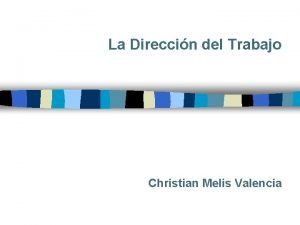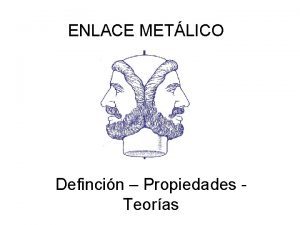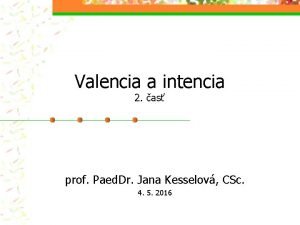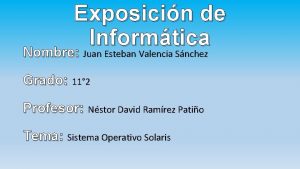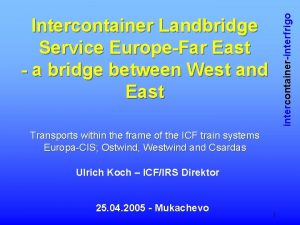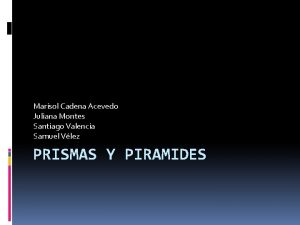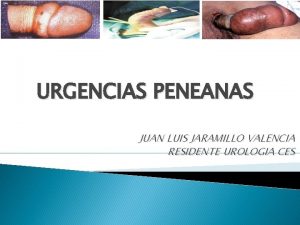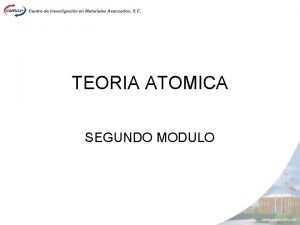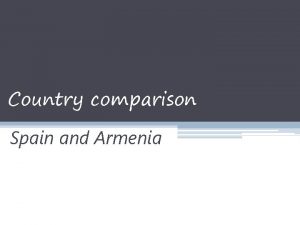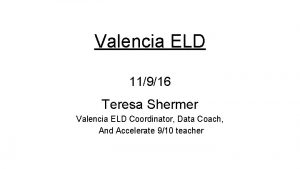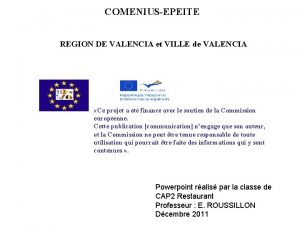EDCC8 28 April 2010 Valencia Spain 28 Valencia

























- Slides: 25

EDCC-8 28 April 2010, Valencia, Spain 28 Valencia, Spain Mobi. Lab The 8 th European Dependable Computing Conference Emulation of Transient Software Faults for Dependability Assessment: A Case Study Roberto Natella, Domenico Cotroneo {roberto. natella, cotroneo}@unina. it www. mobilab. unina. it The Mobi. Lab Group Dipartimento di Informatica e Sistemistica, Università degli Studi di Napoli Federico II Via Claudio 21, 80125 - Napoli, Italy cotroneo@unina. it

: : . Outline EDCC-8 28 April 2010 Valencia, Spain 2 / 22 Mobi. Lab v Context and problem statement v. Software Fault Injection v. Bohrbugs and Mandelbugs v Case study from the ATC domain v Evaluation of state-of-the-art fault injection v An experiment involving concurrency faults v Conclusions www. mobilab. unina. it cotroneo@unina. it

: : . Rationale (1/2) Mobi. Lab EDCC-8 28 April 2010 Valencia, Spain 3 / 22 t Software faults represent an important cause of system failures t Despite of efforts on Verification activities, fault avoidance, and fault removal, software systems are often delivered with residual software faults t Critical systems adopt Fault Tolerance Mechanisms (FTMs) to avoid failures at run-time www. mobilab. unina. it cotroneo@unina. it

: : . Rationale (2/2) EDCC-8 28 April 2010 Valencia, Spain 4 / 22 Mobi. Lab t FTMs: A few examples § Spatial redundancy • CORBA FT, TANDEM 90 Process Pairs § Temporal redundancy • Checkpointing and rollback t Software Fault Injection (SFI) is a valuable approach for the verification and the improvement of FTMs t To correctly emulate software faults, we need to understand their features www. mobilab. unina. it cotroneo@unina. it

: : . Software Faults EDCC-8 28 April 2010 Valencia, Spain 5 / 22 Mobi. Lab t Bohr. Bugs § Faults whose activation is reproducible, i. e. , it is straightforward to identify its activation pattern § Typically detected and then fixed during testing phase t Mandel. Bugs § Faults whose activation is transient and not systematically reproducible § Their activation conditions depend on complex combinations of user inputs, the internal state and the external environment www. mobilab. unina. it cotroneo@unina. it

: : . Problem statement Mobi. Lab EDCC-8 28 April 2010 Valencia, Spain 6 / 22 t Mandelbugs represent the major cause of failure in mission-critical system §. . up to 82 % in well-tested software [2] [5] [6] t Mandelbugs are typically tolerated by the adoption of several redundancy schemes t Are existing SFI techniques able to emulate Mandelbugs adequately? t How should Mandelbugs be emulated? www. mobilab. unina. it cotroneo@unina. it

: : . Software Fault Injection (SFI) Mobi. Lab EDCC-8 28 April 2010 Valencia, Spain 7 / 22 t To date, representativeness of injected faults has still not been investigated with respect to: § Fault manifestation; § Their effectiveness in testing FTMs (i. e. , to emulate faults that most often occur and that they should tolerate) www. mobilab. unina. it cotroneo@unina. it

: : . Contributions Mobi. Lab EDCC-8 28 April 2010 Valencia, Spain 8 / 22 t We aim to investigate this issue with a simple experimental campaign but… …. in a complex and real-world software sytems § We evaluated G-SWFIT, with respect to Mandelbugs § We compared the results with an experiment, specifically designed to emulate Mandelbugs t Case study: a fault-tolerant system from the Air Traffic Control (ATC) domain § It is a Flight Data Processor (FDPS) based on a CORBA-compliant middleware www. mobilab. unina. it cotroneo@unina. it

: : . Case study (1/2) Mobi. Lab www. mobilab. unina. it EDCC-8 28 April 2010 Valencia, Spain 9 / 22 cotroneo@unina. it

EDCC-8 28 April 2010 Valencia, Spain : : . Case study (2/2) 10 / 22 Mobi. Lab t We modeled the FDPS as a FSM to support the analysis of faults t A state consists of the following internal variables: 1) The number of FDP requests queued by the Façade 2) The number of requests under processing 3) The number of requests queued by Processing Servers (PSs) t CR, FR, PSC, …, are the messages exchanged in the FDPS www. mobilab. unina. it cotroneo@unina. it

: : . Experimental campaign using G-SWFIT (1/4) EDCC-8 28 April 2010 Valencia, Spain 11 / 22 Mobi. Lab t We implemented G-SWFIT fault operators in an open-source fault injection tool t The tool analyzes a C/C++ source code file, to produce a set of faulty source files § Freely available at: http: //www. mobilab. unina. it/SFI. htm + C preprocessor C/C++ Source Files www. mobilab. unina. it C/C++ frontend 2 ÷ 6 3 Abstract Syntax Tree Fault Injector int main() { if( a && b ) { c++; } } Patch Files (with faults) cotroneo@unina. it

: : . Experimental campaign using G-SWFIT (2/4) EDCC-8 28 April 2010 Valencia, Spain 12 / 22 Mobi. Lab t 533 faults have been injected in the Façade source code t 1599 experiments (3 different workloads) t For each experiment, we collected: • Information about a failure (e. g. , Façade crash, switch to the backup, missed FDP requests) • The state in which a failure occurred • The state in which the fault was activated www. mobilab. unina. it cotroneo@unina. it

: : . Experimental campaign using G-SWFIT (3/4) EDCC-8 28 April 2010 Valencia, Spain 13 / 22 Mobi. Lab t G-SWFIT is useful to test important system states (e. g. , the checkpointing mechanism) t However, faults did not emulate well Mandelbugs because: § A great amount of faults (56%) manifest themselves during Façade initialization or during the first request (state 0: 0: 0); but Mandelbugs usually manifest themselves during the operational phase of a system www. mobilab. unina. it faults activated failures cotroneo@unina. it

: : . Experimental campaign using G-SWFIT (4/4) Mobi. Lab t However, faults did not emulate well Mandelbugs because (CONTINUED): § In most of cases (93%) in which the backup Façade is activated, the backup also fails (i. e. , fault activation is simple to reproduce, like Bohrbugs) § Some important states (potentially affected by Mandelbugs) are untested (e. g. , when one or more requests are queued by the PSs) § State coverage: 65% www. mobilab. unina. it EDCC-8 28 April 2010 Valencia, Spain 14 / 22 cotroneo@unina. it

: : . Concurrency fault emulation (1/3) Mobi. Lab EDCC-8 28 April 2010 Valencia, Spain 15 / 22 t To emulate Mandelbugs, we analyzed the scientific literature on software faults t We identified the following fault triggers: § Concurrency § Timing of external events § Wrong memory state § Faulty error handlers § Complex input sequences § Software aging www. mobilab. unina. it cotroneo@unina. it

: : . Concurrency fault emulation (2/3) Mobi. Lab EDCC-8 28 April 2010 Valencia, Spain 16 / 22 t Features of most frequent concurrency faults (from a field data study [29]): § They are atomicity-violation faults (49%) § Only 1 shared variable is involved (66%) § At most 2 threads are needed to trigger the fault (90%) t Our fault model: § 2 threads access to a shared variable without acquiring a lock (race condition) www. mobilab. unina. it cotroneo@unina. it

: : . Concurrency fault emulation (3/3) Mobi. Lab EDCC-8 28 April 2010 Valencia, Spain 17 / 22 t We propose a fault emulation technique in two phases: t Fault injection: § Collects information about critical regions and their memory accesses § Removes lock operations before and after a pair of conflicting critical regions t Trigger injection : § Submits an input sequence to drive the system to a target state § Schedules 2 threads such that memory accesses interfere with each other www. mobilab. unina. it cotroneo@unina. it

: : . Preliminary system characterization 18 / 22 Mobi. Lab t Focusing on fault triggering we have to profile the system to recognize (and then to drive) the operating state t An input is associated to: § A sequence of messages sent and received by the Façade § A sequence of lock and memory accesses www. mobilab. unina. it EDCC-8 28 April 2010 Valencia, Spain sent by the tester cotroneo@unina. it

: : . How to trigger a fault? Mobi. Lab EDCC-8 28 April 2010 Valencia, Spain 19 / 22 t An algorithm identifies (i) which inputs to send and (ii) in which state to send inputs to trigger a fault t The algorithm exploits preliminary information to match messages with shared memory accesses www. mobilab. unina. it cotroneo@unina. it

: : . An example of concurrency fault (1/2) EDCC-8 28 April 2010 Valencia, Spain 20 / 22 Mobi. Lab An algorithm Lock. CR The Thread CRQ operation processes 2 1 input is blocked writes reads isis omitted the sent an the sent. FSM to find when(faulty) to sendvalue inputs (next slide) inconsistent value www. mobilab. unina. it cotroneo@unina. it

: : . Experimental campaign using concurrency faults Mobi. Lab EDCC-8 28 April 2010 Valencia, Spain 21 / 22 t 4 injected concurrency faults lead to a failure of primary Façade and not the backup one t We covered 13 out of 14 states (93%) in which faults were injected t Cumulative state coverage: 95% § In particular, states *: 3: 1 were tested (i. e. , one or more requests queued by PSs) www. mobilab. unina. it cotroneo@unina. it

: : . Lessons Learned Mobi. Lab EDCC-8 28 April 2010 Valencia, Spain 22 / 22 t Are existing SFI techniques able to emulate Mandelbugs adequately? § No, G-SWFIT should be complemented by taking into account Mandelbugs t How should Mandelbugs be emulated? § Our solution is to identify most common fault triggers, and to try to emulate them in addition to modifying the source code www. mobilab. unina. it cotroneo@unina. it

EDCC-8 28 April 2010 Valencia, Spain : : . Mobi. Lab Thank you! Any questions? www. mobilab. unina. it cotroneo@unina. it

EDCC-8 28 April 2010 Valencia, Spain : : . Mobi. Lab Backup slides www. mobilab. unina. it cotroneo@unina. it

: : . G-SWFIT fault operators EDCC-8 28 April 2010 Valencia, Spain Mobi. Lab t G-SWFIT fault operators were derived from a field data study [14] : -D t Fault activation and manifestation were neglected due to lack of data www. mobilab. unina. it cotroneo@unina. it
 Inheritance tax valencia region spain
Inheritance tax valencia region spain Josefina valencia
Josefina valencia Melis valencia
Melis valencia Comentario plano urbano valencia
Comentario plano urbano valencia Brazilian model ana carolina reston
Brazilian model ana carolina reston Inditex valencia
Inditex valencia Electrones.de valencia
Electrones.de valencia Banda valencia
Banda valencia Intencie
Intencie Valencia ecologica
Valencia ecologica Juan esteban valencia vargas
Juan esteban valencia vargas Aula virtual universidad de valencia
Aula virtual universidad de valencia Galloo group
Galloo group Varicocele
Varicocele Conference center valencia
Conference center valencia Seaborgio valencia
Seaborgio valencia Valencia merble
Valencia merble Camda de valencia
Camda de valencia Oportunidades valencia
Oportunidades valencia Intercontainer valencia
Intercontainer valencia Hidrgeno
Hidrgeno Fundasababe valencia
Fundasababe valencia Juliana valencia montes
Juliana valencia montes Grafies de la essa sorda
Grafies de la essa sorda Juan luis jaramillo valencia
Juan luis jaramillo valencia Quien descubrio el proton
Quien descubrio el proton


